CLUSTER TRAINING FOR BOXING
Cluster Training is an effective way for strength, speed and muscle hypertrophy…. but what is cluster training? How does cluster training work? And how to perform cluster training?
Cluster training also known as rest-pause training is an innovative means of manipulating a typical training set to minimise fatigue and maximise the volume load for that given set.
This is considered an advanced training technique, used to accelerate gains in muscle growth, strength and power among athletes who are relatively well-trained.
Considering the importance of force production and the rate at which this force is produced to the punching action, cluster training can be viewed as an added strength training method for maximising these muscle force qualities that significantly influence performance in boxing and other combat sports.
With this said, the following sections will discuss:
A breakdown of Cluster Training and the physiological mechanisms that underpin it’s implementation.
The effectiveness of Cluster Training according to the current body of evidence.
The specific benefits of Cluster Training for a boxer.
How to integrate cluster training into your program
WHAT IS CLUSTER TRAINING?
Cluster training involves breaking a traditional set up by incorporating a brief rest period or periods throughout a set.
These rest periods may be incorporated once or at numerous time points throughout a set and tend to be 10-30 seconds in duration depending on the given training goal.
Example using one rest period during a 6 rep set with the back squat: 120 kg x 3 Reps, rest 15-20s, perform another 3 repetitions using the same weight load.
Example using multiple rest periods during a 6 rep set with the back squat: 120kg x 2 Reps, rest 10s, perform another 2 reps, rest again for 10s before performing the final 2 repetitions and taking an extended rest prior to the next set.
This ultimately reduces the degree of fatigue that would be typically accumulated during a traditional set and therefore maximises the load lifted as well as the speed at which this load is lifted.
Using this set configuration will also allow you to lift higher loads for more repetitions, therefore increasing volume-load (Load x Sets x Repetitions), which is a key driver of muscle hypertrophy and strength (1,2).
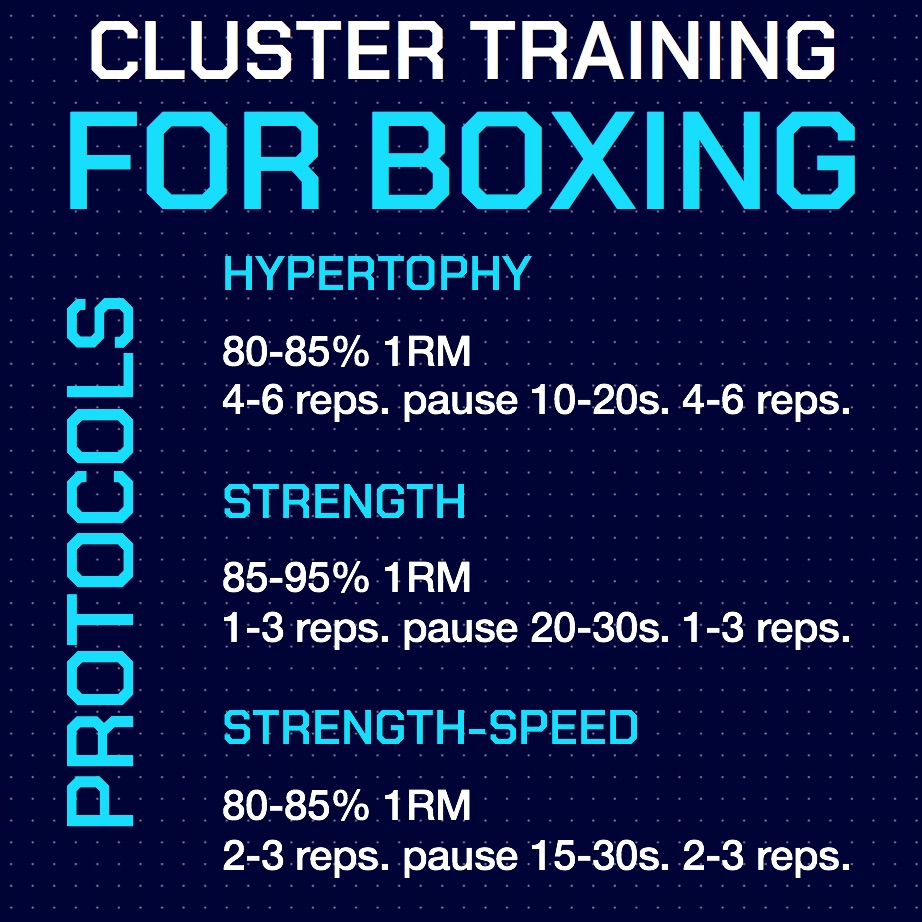
HOW DOES CLUSTER TRAINING WORK?
There are two distinct responses to maximal or near-maximal contractions; fatigue and post activation potentiation (PAP) (3).
Fatigue will naturally have a detrimental effect on neuromuscular performance, reducing force production and power output.
Conversely, PAP yields acute improvements in muscle function including rate of force development and peak power output due to heightened neural activity resulting from increased stimulation of high threshold motor units (3).
A substantial amount of research has outlined the application of PAP in various aspects of sporting performance and forms the basis of another advanced strength training method, known as complex training.
For more on complex training for boxing, read our article on the topic here .
Whilst the concept of PAP has been mainly implemented as a means of acutely improving sprint and jump performance, using cluster training we can maximise the intra-set PAP response, enabling the athlete to maintain or even increase performance as the set prolongs.
This PAP response using Cluster training can be highlighted when tracking bar speed.
In other words, if performing a 6 rep set of back squats at 85% 1RM, using the cluster format of 2 reps, rest, 2 reps, rest etc we can often see increases in bar speed from the first two repetitions to the last two repetitions due to the PAP response of lifting heavier weight loads.
In the absence of an increase, we can at least expect to maintain movement speed throughout a set, therefore maximising strength-speed or power adaptations (4).
Without the inclusion of rest periods i.e traditional strength training, a decline in movement speed and set quality is seen across the set as a result of neuromuscular fatigue accumulation (4).
A strength trainee may encounter such muscular fatigue after as few as 5-9 repetitions and may be a result of lactate accumulation (5).
The brief intra-set rest periods (10-30s) help to off-set muscular fatigue and subsequent reductions in muscle force characteristics through the partial replenishment of the ATP-Pcr system which is the primary energy pathway for maximal or near maximal muscular contractions (6).
In contrast, traditional sets of maximal/near maximal muscular contractions are likely to induce high levels of lactate and reduced ATP-Pcr stores, decreasing muscle force production and power output as the set continues (7).
This is essentially where we see ‘grinding’ repetitions with bar speed being considerably slower on the final repetition compared to the first rep.

DO WE NEED TRADITIONAL RESISTANCE TRAINING SETS THEN?
Though we have highlighted the benefits of cluster training above, we are by no means suggesting that cluster training should replace traditional strength training sets.
Cluster training should be viewed as another tool in the toolbox to further drive hypertrophy, strength and power adaptations, particularly in advanced athletes.
Traditional strength training will always have a role for beginner trainees to develop the foundational strength and musculo-tendinous integrity required to withstand more advanced training methods.
For advanced athletes, exposure to muscle fatigue, metabolite accumulation greater time under tension associated with traditional sets is needed in certain cases, particularly during general preparation stages, to promote increases in muscle size and strength as well as overall work capacity (8, 9).
For more on how we progress the athletes we work with to advanced training methods click here.
CLUSTER TRAINING: EFFECTIVENESS
Since the initial review by Haff and colleagues in 2009, an ample amount of research has aimed to determine whether cluster set training is more beneficial/effective the traditional set formats.
Similar to many concepts in the field of exercise science and athletic performance preparation, it is not a case of one is better than the other, but rather a given method may be preferable in a particular context.
This is highlighted in a recent analysis of the evidence to date on cluster versus traditional strength training sets conducted by Davies and colleagues (10).
The authors concluded that long term use of either cluster or traditional strength training demonstrate equal effectiveness in terms of strength, hypertrophy, power and muscular endurance development, however, cluster training may achieve these adaptations whilst accumulating less neuromuscular fatigue.
By not accumulating as much fatigue, cluster training can have a specific application to training phases where repetition quality and movement speed are prioritised under high loads, for example, strength-speed or power phases.
Aside from power development, cluster training may be more favourable in certain circumstances for developing maximal force using complex, multi-joint lifts due to the minimisation of fatigue, therefore promoting technique maintenance (11).
This will likely be more rewarding for athletes who are newly exposed to near maximal loads (85-95% 1RM) or who have high training demands outside of strength training, a prime example being boxers.
The fact that no differences in muscle hypertrophy between cluster training and traditional strength training were observed in the analysis is a key finding and highlights the importance of mechanical stress as driver of muscle growth.
Mechanical stress depends on the load used for a given a lift. The higher the load, the greater the stimulus for cell signalling pathways that regulate muscle protein synthesis (13,14).
Previous research has found that cluster training can increase the mechanical stress imposed on the athlete during a set whilst maintaining movement velocity (12).
This combination of higher loads, moved at greater speeds is optimal for fast-twitch fiber recruitment and hypertrophy (13), therefore, facilitating functional muscle mass development that will add to the performance of explosive sporting tasks such as sprinting, jumping and punching, rather than hinder it.
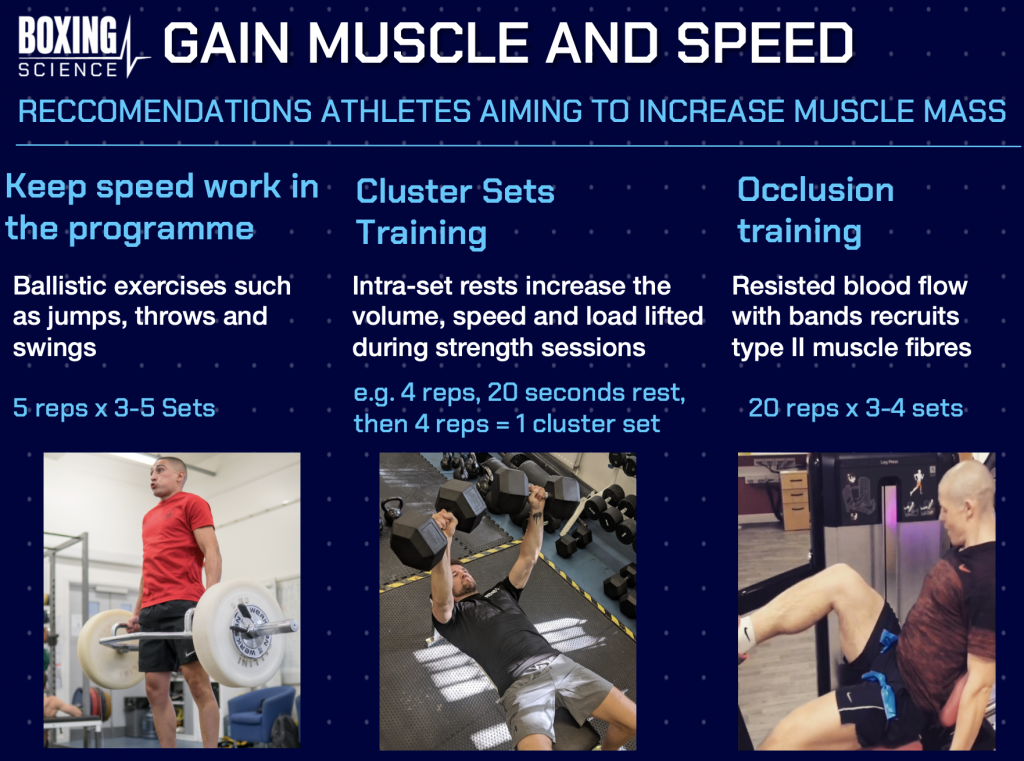
BENEFITS FOR BOXING
Having outlined the mechanisms of cluster training and referred to the effectiveness of this set manipulation compared to the traditional set format, why might cluster training be beneficial for boxers…?
Maximal Strength Development With Less Fatigue
As eluded to previously, boxer’s have substantial training demands outside of strength training.
In the midst of training camp strength training may be fourth or fifth on the list of priorities, behind sparring, technical training, metabolic conditioning and even nutritional or recovery strategies.
Considering this, it is vital as strength and conditioning coaches to apply methods that produce the desired training adaptations without compromising other aspects of a boxer’s preparation.
Thus, cluster sets can be used to expose the athlete to maximal and near maximal loads to develop high levels of maximal strength without accumulating as much neural fatigue as traditional strength training.
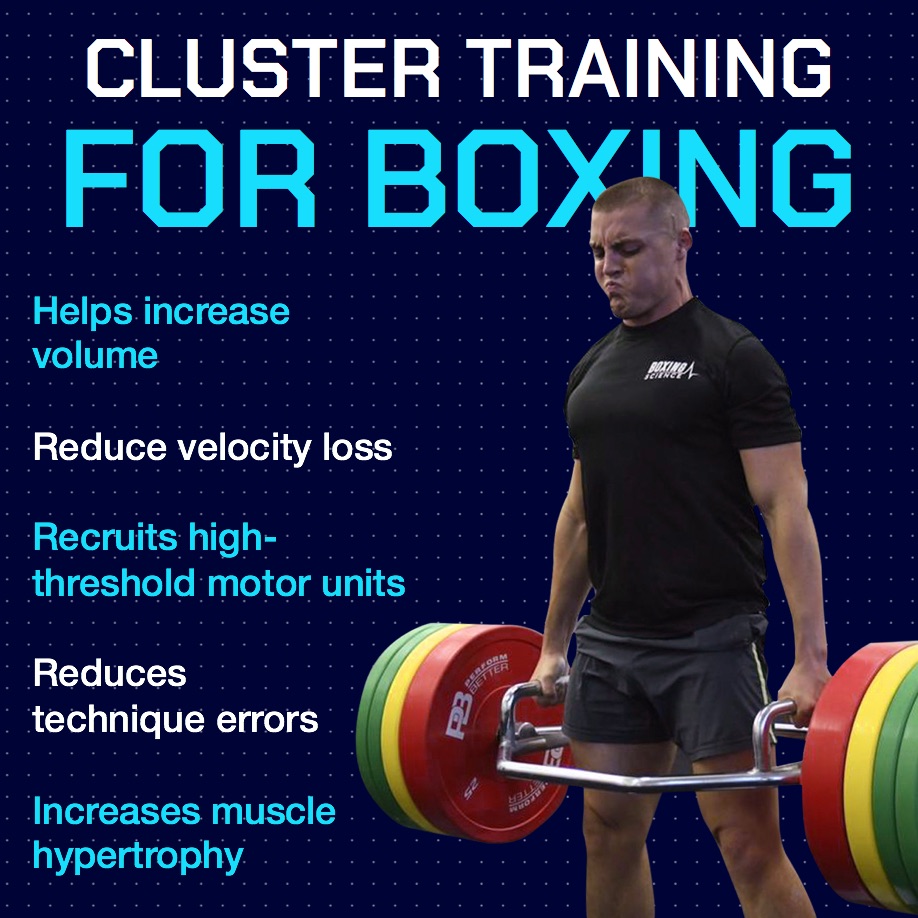
Moreover, cluster sets will likely increase the amount of weight that can be lifted for a given number of repetitions, maximising neural adaptations and subsequent strength development (12).
You may be asking yourself ‘why is maximal strength important for boxing?’
We have previously outlined the need for maximal strength development here and across our social media platforms.
Briefly, maximal strength or force is strongly associated with rate of force development (16).
We know that there is a significant relationship between lower body rate of force development and punch performance.
Therefore, improving the magnitude of force that can be produced from the lower body, using heavy squat and deadlift variations can help improve the rate at which this force is produced and therefore contribute to enhanced punch force.
Evidently, cluster training can be viewed as an effective training method to help maximise punch force whilst minimising decrements to other aspects of training.
Muscle AND Speed
Boxing is a weight category sport and, therefore, gaining muscle mass, more often than not, is viewed as a negative by product of strength training.
In some instances, however, using strength training to increase functional mass is needed.
A common example is boxers who wish to move up a weight category whilst maintaining their speed, quickness and punch power.
Also, the heavyweight division is consistently getting bigger and stronger and therefore increasing functional muscle mass is often a training goal for those already in the division or those moving up from cruiser or light heavyweight.
This is because with more mass comes more momentum and subsequently greater impulse which is a key metric of punch power.
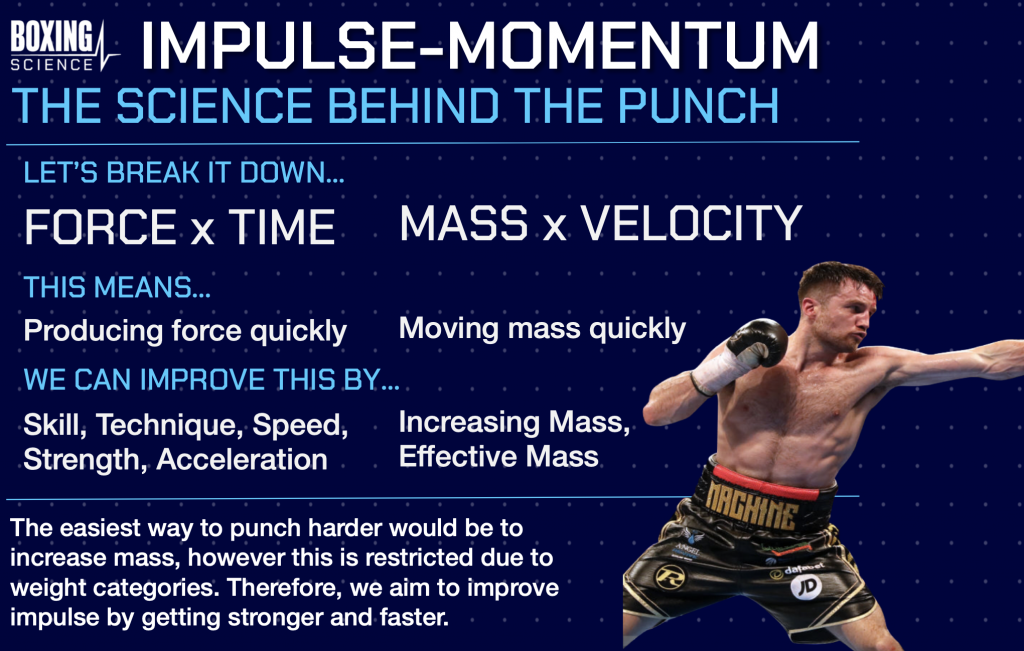
Traditional bodybuilding methods have some application in these instances, however, should be minimal as we are ultimately increasing the likelihood of developing mass that does not contribute to improved force production and is likely to significantly increase muscle soreness.
As mentioned previously, cluster training can help maximise type II muscle fiber recruitment and development through increased mechanical tension without decreasing relative movement velocity (12).
As such, using cluster sets with key lifts such as the back squat, trap bar deadlift and horizontal press may be a preferable training method to concurrently develop muscle size and strength for athletic performance compared to traditional strength training.
Strength-Speed/Power Development
In the initial review of cluster training in 2009 (4), maintaining or improving movement velocity throughout a set, using the same load, was the main concept that the authors focused on to support the preferential use of cluster training over traditional strength training in the context of power development.
Power, like rate of force development, is considered a key physical attribute for many sporting actions, including punching, and is developed using a combination of strength training methods, most notably, maximal strength and ballistic strength training (17).
The basic physics definition of power is the rate of doing mechanical work.
In an S&C context power may be defined as Force x Velocity and therefore maximising both sides of this equation is important for power development.
This is why olympic lifts are widely regarded as the primary exercises for developing neuromuscular power as they allow athletes to move relatively heavy loads, quickly, therefore targeting both force and velocity aspects of the power equation.
Due to the complexity and high neurological demand of olympic lifts fatigue is often an issue that compromises the effectiveness and quality of the set.
As a result, adopting a cluster set format when performing olympic lifts, particularly with beginner strength trainees who may not be technically proficient, has been recommended to maximise power training adaptations (18, 19).
Intra-set rest periods can also be applied to sets of other ballistic movements that focus on power development.
At Boxing Science we are big proponents of trap-bar jumps and jump squats for boxers during strength-speed phases to promote improvements in lower body rate of force development and power.
Though we have used and continually use olympic lifting variations, these can be a less time efficient means of improving RFD and power with boxers due to the time it takes to achieve technical proficiency.
In contrast, loaded jumps are significantly less technically demanding and therefore allow for maximal intent and movement speed with each repetition.
Barbell velocity during heavier (50-70% 1RM) loaded jumps may be further enhanced using cluster set protocols, therefore optimising power outputs across a set.
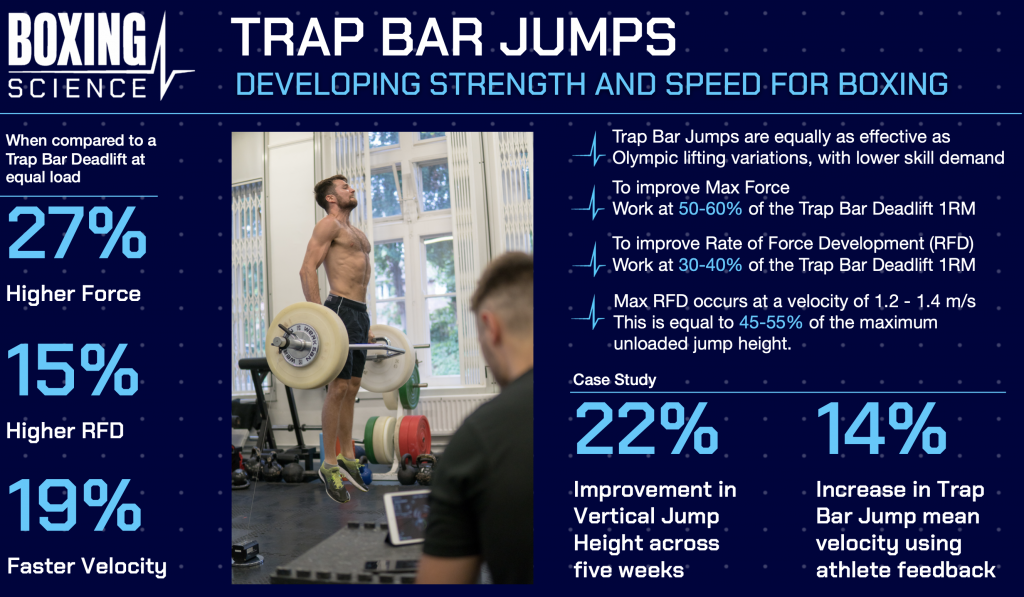
PROGRAMMING
When to use and how to use cluster training for boxing?
Considering cluster training is an advanced training strategy it is important to apply it in the correct circumstances to get the most benefit.
At Boxing Science, we tend to use cluster training with our more advanced athletes on the program.
This is because stronger individuals tend to achieve a greater potentiation response from lifting heavier loads and realise this response quicker compared to weaker athletes (3).
Additionally, stronger athletes are more able to tolerate higher volumes at heavier weight loads.
We tend to implement cluster sets in the early stages of camp prior to maximal strength phases.
This helps to gradually expose the athlete to heavier loads and begin to accumulate volume load at these high percentages (85-95%) of their 1RM.
Traditional Bench Press Set @ 8RM = 90kg x 8 reps = 720 kg
Cluster Set Bench Press @ 6RM = 100kg x 4 reps (pause 20s) x 4 reps = 800 kg
Resistance x Reps = Volume Load
Traditional Bench Press Set @ 8RM = 720 x 4 sets = 2880kg
Cluster Set Bench Press @ 6RM = 800 x 4 sets = 3200 kg
Depending on the protocol used we can maximise either hypertrophy or strength responses from cluster training during the early stages of camp.
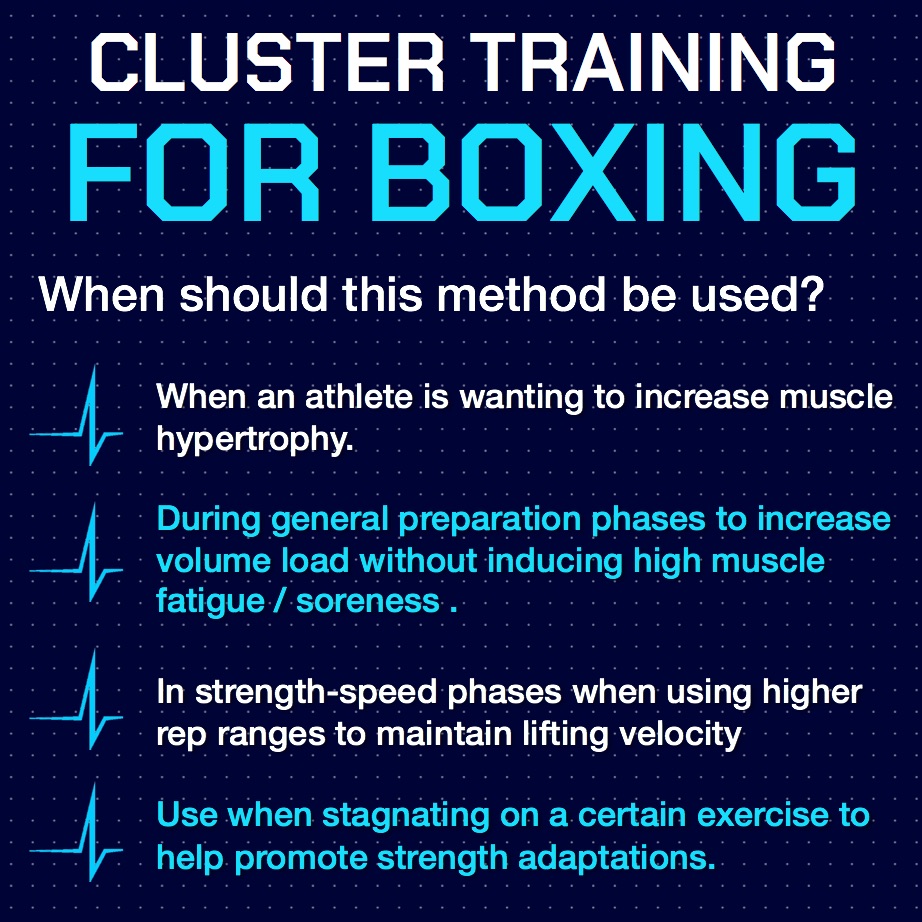
Clusters for Hypertrophy
Recommendations from Haff and colleagues (4) for maximising the hypertrophy response from cluster training include:
Intra-set rest periods of 10-20s
Sets of 8-12 repetitions
These sets should consist of 1-2 intra-set periods.
There are many ways to apply these guidelines, practical examples for compound lifts such as the back squat, deadlift and press may include:
5RM / 85% 1RM: 4 reps. Pause 15 – 20 secs. 4 reps
5RM / 80% 1RM: 4 reps. Pause 10 secs. 3 reps. Pause 10 secs. Max reps.
8RM / 75% 1RM: 6 reps. Pause 10 secs. 6 reps.
10RM / 70% 1RM: 8 reps. Pause 10 secs. 6 reps.
Clusters For Strength
Cluster protocols for maximising strength development are similar to those for hypertrophy, however the intra-set rest periods should be longer as the intensity will more than likely be greater.
The review mentioned previously (4) does not provide distinct guidelines for the use of cluster training for maximal strength development, however here are examples of clusters we have implemented, successfully, with the athletes we work with at Boxing Science:
3RM/85-95% 1RM: 1-3 reps, pause 20-30 secs. 1-3 reps.
3RM+ / 90-95% 1RM: 2 reps. Pause 20-30 secs. 1 rep. Pause 20 secs. 1 rep.
~1RM / 95-100% 1RM: 1 rep. Pause 20-30 secs. 1 rep
Clusters for Strength-Speed/Power
To maximise power development using cluster set configurations, longer rest periods, usually in the range of 30-45 seconds are required (4).
The aim of the longer rests periods is to allow for greater recovery, promoting the achievement and maintenance of higher power outputs.
Examples of clusters that can be implemented with this goal in mind using olympic lifting variations include:
95-100% 1RM: 1 rep. Pause 30-45 secs. 1 Rep.
85% 1RM: 2 reps. Pause 30-45 secs. 2 reps. Pause 30-45 secs. 2 reps.
Clean/Snatch Complex: Hang clean/Snatch pulls x 2-3 reps. Pause 30-45 secs. Full clean/snatch x 2-3 reps
Examples of cluster sets using the trap-bar jump may include:
60-70% Trap Bar Deadlift 1RM: 1 rep. Pause 30-45 secs. 1 Rep. Pause 30-45 secs. 1 Rep.
40-50& Trap Bar Deadlift 1RM: 1 Rep. Pause 20 secs. 1 Rep. Pause 20 secs. 1 Rep.
SUMMARY
Cluster set training is an advanced and innovative strength training strategy that places brief rest periods within a working set to maintain repetition quality and bar speed.
Cluster training maintain bar speed throughout a set by allowing partial restoration of the ATP-Pcr system, thus minimising fatigue accumulation and subsequent muscle force impairment.
Based on a comprehensive analysis of the evidence to date (10), cluster set training is equally effective as traditional strength training in eliciting improvements in muscular size, strength and power and achieves these adaptations without accumulating the same levels of fatigue.
Benefits of cluster set training for boxers include functional muscle mass development, maximal strength development without impairing other aspects of performance and maximal neuromuscular strength-speed or power development.
REFERENCES
- Schoenfeld, B.J., Ratamess, N.A., Peterson, M.D., Contreras, B., Sonmez, G.T. and Alvar, B.A., 2014. Effects of different volume-equated resistance training loading strategies on muscular adaptations in well-trained men. The Journal of Strength & Conditioning Research, 28(10), pp.2909-2918.
2. Schoenfeld, B. and Grgic, J., 2018. Evidence-based guidelines for resistance training volume to maximize muscle hypertrophy. Strength & Conditioning Journal, 40(4), pp.107-112.
3. Tillin, N.A. and Bishop, D., 2009. Factors modulating post-activation potentiation and its effect on performance of subsequent explosive activities. Sports medicine, 39(2), pp.147-166.
4. Haff, G.G., Hobbs, R.T., Haff, E.E., Sands, W.A., Pierce, K.C. and Stone, M.H., 2008. Cluster training: A novel method for introducing training program variation. Strength & Conditioning Journal, 30(1), pp.67-76.
5. Viitasalo, J.T. and KOMI, P.V., 1981. Effects of fatigue on isometric force‐and relaxation‐time characteristics in human muscle. Acta Physiologica Scandinavica, 111(1), pp.87-95.
6. Haff, G.G., Whitley, A.D.R.I.A.N., McCoy, L.B., O’Bryant, H.S., Kilgore, J.L., Haff, E.E., Pierce, K. and Stone, M.H., 2003. Effects of different set configurations on barbell velocity and displacement during a clean pull. Journal of Strength and Conditioning Research, 17(1), pp.95-103.
7. Sahlin, K. and Ren, J.M., 1989. Relationship of contraction capacity to metabolic changes during recovery from a fatiguing contraction. Journal of Applied Physiology, 67(2), pp.648-654.
8. González-Hernández, J.M., García-Ramos, A., Castaño-Zambudio, A., Capelo-Ramírez, F., Marquez, G., Boullosa, D. and Jiménez-Reyes, P., 2020. Mechanical, metabolic, and perceptual acute responses to different set configurations in full squat. The Journal of Strength & Conditioning Research, 34(6), pp.1581-1590.
9. Joy, J.M., Oliver, J.M., McCleary, S.A., Lowery, R.P. and Wilson, J.M., 2013. Power output and electromyography activity of the back squat exercise with cluster sets. J Sports Sci, 1, pp.37-45.
10. Davies, T.B., Tran, D.L., Hogan, C.M., Haff, G.G. and Latella, C., 2021. Chronic Effects of Altering Resistance Training Set Configurations Using Cluster Sets: A Systematic Review and Meta-Analysis. Sports Medicine, pp.1-30.
11. Hardee, J.P., Lawrence, M.M., Zwetsloot, K.A., Triplett, N.T., Utter, A.C. and McBride, J.M., 2013. Effect of cluster set configurations on power clean technique. Journal of sports sciences, 31(5), pp.488-496.
12. Tufano, J.J., Conlon, J.A., Nimphius, S., Brown, L.E., Banyard, H.G., Williamson, B.D., Bishop, L.G., Hopper, A.J. and Haff, G.G., 2017. Cluster sets: permitting greater mechanical stress without decreasing relative velocity. International journal of sports physiology and performance, 12(4), pp.463-469.
13. Goldberg, A.L., Etlinger, J.D., Goldspink, D.F. and Jablecki, C., 1975. Mechanism of work-induced hypertrophy of skeletal muscle. Medicine and science in sports, 7(3), pp.185-198.
14. Hornberger, T.A., Stuppard, R., Conley, K.E., Fedele, M.J., Fiorotto, M.L., Chin, E.R. and Esser, K.A., 2004. Mechanical stimuli regulate rapamycin-sensitive signalling by a phosphoinositide 3-kinase-, protein kinase B-and growth factor-independent mechanism. Biochemical Journal, 380(3), pp.795-804.
15. Fry, A.C., 2004. The role of resistance exercise intensity on muscle fibre adaptations. Sports medicine, 34(10), pp.663-679
16. Andersen, L.L. and Aagaard, P., 2006. Influence of maximal muscle strength and intrinsic muscle contractile properties on contractile rate of force development. European journal of applied physiology, 96(1), pp.46-52.
17. Cormie, P., McGuigan, M.R. and Newton, R.U., 2011. Developing maximal neuromuscular power. Sports medicine, 41(1), pp.17-3
18. Lawton, T.W., Cronin, J.B. and Lindsell, R.P., 2006. Effect of interrepetition rest intervals on weight training repetition power output. Journal of Strength and Conditioning Research, 20(1), p.172.
19. Rooney, K.J., Herbert, R.D. and Balnave, R.J., 1994. Fatigue contributes to the strength training stimulus. Medicine and science in sports and exercise, 26(9), pp.1160-1164.
